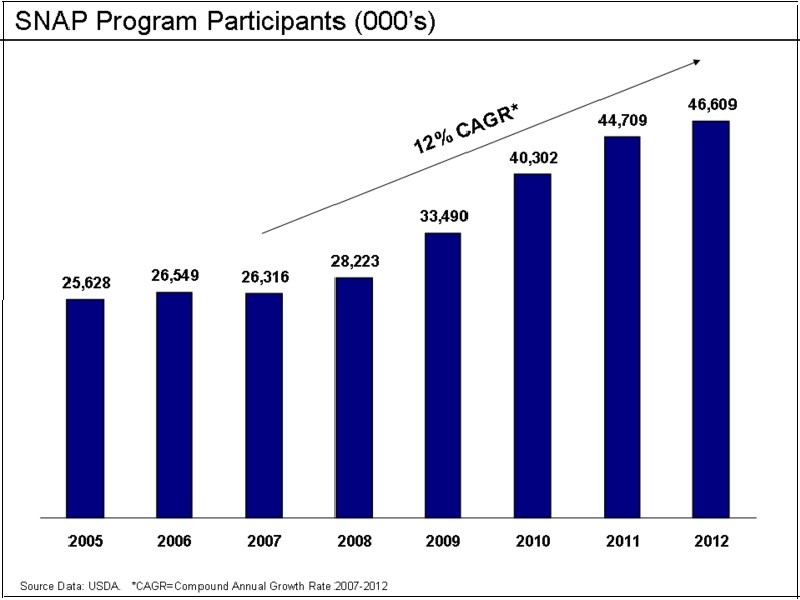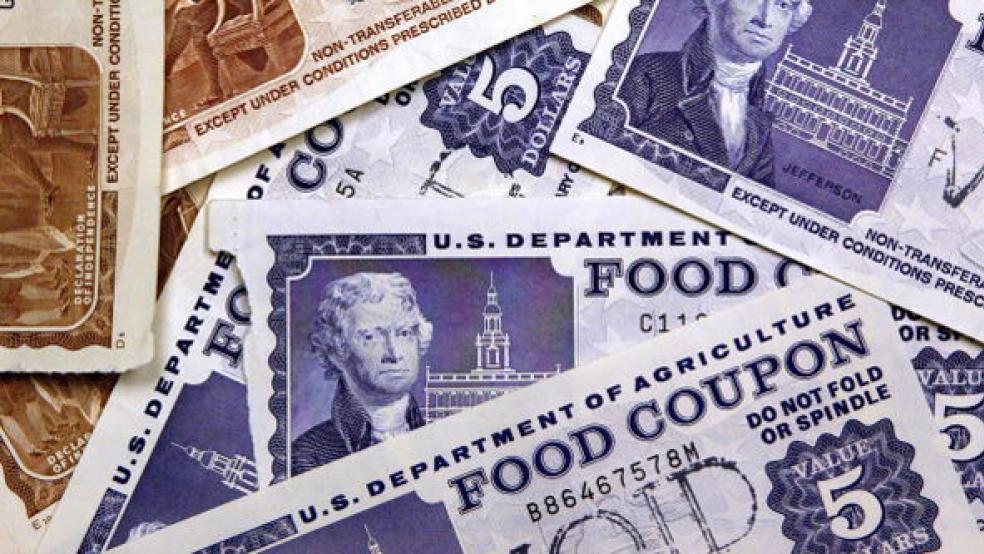 Spending on federal food stamps was cut on Friday by $5 billion for the remainder of the fiscal year – and Congress didn’t have to lift a finger to achieve those savings.
Spending on federal food stamps was cut on Friday by $5 billion for the remainder of the fiscal year – and Congress didn’t have to lift a finger to achieve those savings.
Like so much else that is happening on the budget front in this era of sequestration, the cuts in the massive nutrition assistance program were achieved automatically – without direct action by lawmakers or the administration.
RELATED: PUZZLING RISE IN FOOD STAMP USE AS ECONOMY IMPROVES
The food stamp program currently costs about $80 billion a year and provides food aid to about 47 million people, or 14 percent of all U.S. households.
The budget for the Supplemental Nutrition Assistance Program (SNAP) was substantially bolstered in 2009 as part of the American Recovery and Reinvestment Act, the stimulus package aimed at helping Americans through the worst economic times of modern history. An additional $45.2 billion was authorized over four years, allowing the food stamps program to temporarily increase monthly benefits to an average of $133.
That bump expires today, and benefits will shrink by around 5 percent on average.
Under today’s automatic cut, a household of three, such as a mother with two children, will lose $29 a month, according to the Center on Budget and Policy Priorities (CBPP), a liberal policy think tank — or a total of $319 over the 11 months left in fiscal 2014. That’s equivalent to about 16 meals a month, CBPP says, based on the cost of the U.S. Agriculture Department’s “Thrifty Food Plan.”
“The SNAP benefit cut will make it even harder for families to put food on the table,” CBPP analysts Dottie Rosenbaum and Brynne Keith-Jennings wrote in a report last week:
“More than 80 percent of SNAP households have monthly income below the federal poverty line ($19,500 a year for a family of three), and more than 40 percent live in deep poverty, with income below half of the poverty line.”
Without the added boost provided by the 2009 stimulus, SNAP benefits will average less than $1.40 per person per meal for this fiscal year. Nationally, the cut will reduce spending by a total of $11 billion from fiscal 2014 through 2016.
"People are living at the margins," Ellen Vollinger, legal director and SNAP advocate at the Food Research and Action Center, an anti-hunger organization, told the Chicago Tribune. "It's not an abstract metric for people. It's actual dollars to keep food in the refrigerator."
RELATED: FIGHT OVER FOOD STAMPS IN A NEARLY $1 TRILLION FARM BILL
The cut will also impact many states. “Studies show that in a distressed economy, every dollar of SNAP benefits creates at least about $1.70 in economic activity, as SNAP recipients spend their benefits on food quickly,” the CBPP report noted. “For example, California and Texas will each lose over $400 million in SNAP benefits that would have helped their residents eat in 2014; the potential economic impact is even greater.”

The automatic cuts are good news for many congressional Republicans and conservatives who are outraged by the massive growth in the food stamp program and complain about rampant fraud and cheating by consumers and merchants.
“While survey after survey shows that Americans understand the value of work in fighting poverty, policymakers in Washington fail to capture this vision,” Rachel Sheffield, a policy analyst at the conservative Heritage Foundation, wrote this week. “The result: Welfare spending climbs, rolls swell, and self-sufficiency flounders. The success of welfare programs such as food stamps is measured by the number of American households receiving assistance rather than by a growth in self-sufficiency.”
RELATED: CRACKDOWN ON FOOD STAMP FRAUD--A $750 MILLION A YEAR SCAM
Moreover, some state governments are pressing to curtail the availability of food stamps to able-bodied Americans, including college students. As Brad Plumer at the Washington Post’s Wonkblog wrote this week:
“In 2013, 44 states qualified for federal waivers that would allow more able-bodied adults to receive food stamps if unemployment in the area was particularly high. House Republicans want to curtail those waivers as part of their farm and food stamp legislation for the coming year. But even if the House GOP doesn't get its way, some states are planning to stop asking for waivers anyway.
“Kansas already let its waiver expire at the start of October, a change that could affect some 20,000 residents. The Oklahoma state legislature passed a bill to add a similar work requirement to its food-stamp program. Ohio is planning to enact similar restrictions starting Jan. 1, and Wisconsin will follow suit next July.”
The House and Senate are currently deadlocked over new spending for the SNAP program. A House-passed bill would cut $40 billion from the program over 10 years, while the Senate agriculture and nutrition bill would cut only about $3.9 billion. A House-Senate conference committee began meeting this week to iron out differences over farm programs and food stamps.





